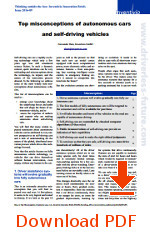
One of the most difficult questions for self-driving cars concerns their safety: How can we determine whether a particular self-driving car model is safe? The most popular answer to this question is based on a straightforward application of statistics and leads to conclusions such as that “…fully autonomous vehicles would have to be driven hundreds of millions of miles and sometimes hundreds of billions of miles to demonstrate their reliability…”. This statement comes from a recent RAND report by Nidri Kalra and Susan Paddock on the topic. Unfortunately, these statements are untenable in this form because the statistical argument contains major oversights and mistakes, which we will point out in the following.
7.1 Failure rate estimation
The argument is usually presented as a problem of failure rate estimation where observed failures (accidents involving self-driving cars) are compared against a known failure rate (accident rates of human drivers). Accidents are modeled as discrete, independent and random events that are determined by a (statistically constant) failure rate. The failure rate for fatal accidents can be calculated by dividing the number of accidents with fatalities by the number of vehicle miles traveled. If we consider the 32,166 crashes with fatalities in traffic in the US in 2015 and relate them to the 3.113 billion miles which motor vehicles traveled, then the failure rate is 32,166 / 3.113 billion = 1.03 fatalities per 100 million miles. The probability that a crash with fatality occurs on a stretch of 1 mile is extremely low (0,0000010273%) and the opposite, the success rate, the probability that no accident with fatality occurs on a stretch of 1 vehicle-mile-traveled (VMT) is very high (99,999998972%). By observing cars driving themselves, we can obtain estimates of their failure rate. The confidence that such estimates reflect the true failure rate increases with the number of vehicle miles traveled. Simple formulas for binomial probability distributions can be used to calculate the number of miles which need to be driven without failure to reach a certain confidence level: 291 million miles need to be driven by a self-driving car without fatality to be able to claim with a 95% confidence level that self-driving cars are as reliable as human drivers. This is nearly three times the distance between fatalities that occur during human driving. If we relax the required confidence level to 50%, then at least 67 million miles need to be driven without fatality before we can be confident that self-driving cars are safe. Although this calculation is simple most authors – including the authors of the RAND report – use the wrong measures. Instead of dividing the number of crashes involving fatalities (32,166) by VMT, they divide the number of fatalities (35,091) by VMT. This overstates the failure rate of human drivers because a single accident may lead to multiple fatalities and the number of fatalities per fatal accident may depend on many factors other than the reliability of the driver.
Continue reading the full text of this misconception or go to the list of misconceptions
